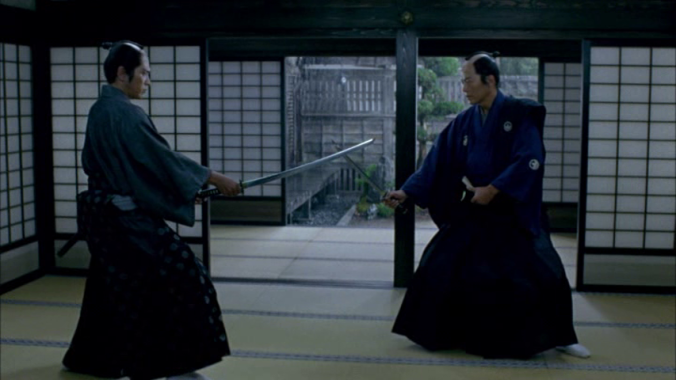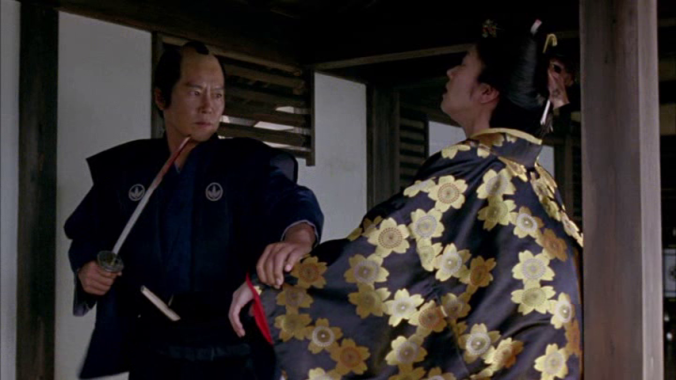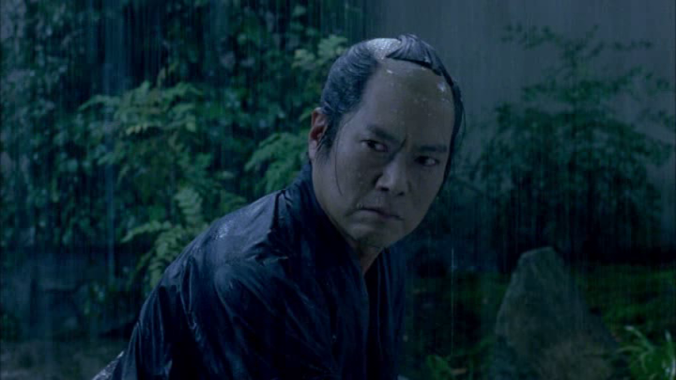 Sword of Desperation takes us back to the days when every chanbara hero had his own unique sword move that was supposedly invincible. Sanzaemon is the man with the famous move called bird-spearing but he has modified it into a move he calls the sword of desperation that can be used only when a man is half dead. The meaning of the term “half-dead” will eventually turn out to be the point around which the whole movie revolves, for the hero Sanzaemon seems half dead from the beginning.
Sword of Desperation takes us back to the days when every chanbara hero had his own unique sword move that was supposedly invincible. Sanzaemon is the man with the famous move called bird-spearing but he has modified it into a move he calls the sword of desperation that can be used only when a man is half dead. The meaning of the term “half-dead” will eventually turn out to be the point around which the whole movie revolves, for the hero Sanzaemon seems half dead from the beginning.
We first meet Sanzaemon watching a Noh performance, after which he politely greets the lord’s favorite concubine Renko and stabs her with his short sword.  Rather surprisingly, he is not executed but is only given a year of house arrest and a reduction in his stipend. He is already half dead, since his beloved wife has died and he has no children, and takes the house arrest further, having himself locked into a single shed where he spends the year thinking. The rest of the house is maintained and his food is provided by his dead wife’s young cousin Rio, who lost her marriage chances due to her association, however distant, with Sanzaemon’s disgrace.
Rather surprisingly, he is not executed but is only given a year of house arrest and a reduction in his stipend. He is already half dead, since his beloved wife has died and he has no children, and takes the house arrest further, having himself locked into a single shed where he spends the year thinking. The rest of the house is maintained and his food is provided by his dead wife’s young cousin Rio, who lost her marriage chances due to her association, however distant, with Sanzaemon’s disgrace.
As he meditates and grows his beard in total silence, we see flashbacks of Renko’s exploitation of her position, gradually taking over much of the business of the clan, increasing taxes on already starving peasants to increase her budget for kimonos, expensively restoring a decrepit temple to provide a relative with a position, and forcing loyal servants to commit hara-kiri when they cross her. Thus, there is the strong implication that the councilor Tsuda put the half-dead Sanzaemon up to her murder, though we see no direct meeting between the two in the flashbacks. This implication is reinforced when Sanzaemon is released, goes on a year’s travel unharmed through the fiefdom, and on his return has his stipend restored and is appointed chief bodyguard to the lord. This eventually brings him face to face with the lord’s cousin Ibiyo, who has sided with the peasants and wants to remove the daimyo to replace him with a lord who would be better for the whole clan.
Ibiyo and Sanzaemon face off in a spectacular indoor duel, katana against the short sword, and eventually Sanzaemon pulls off a trick move that allows him to kill Ibiyo. But there are wheels within wheels, and this is only the beginning of a spectacular battle indoors and out in the pouring rain and the final revelation of Sazaemon’s real Sword of Desperation move that can hold its own against any of the famous swordplay scenes of the sixties or seventies.
Until that scene, this is one of the quietest of all the chanbara. No one raises their voice, no one speaks their true feelings. Tsuba once comments about the daimyo, “He has the bad habit of saying what he thinks.” This is a bad habit no one else in the movie ever adopts, not even Renko, whose selfish viciousness is always masked by her pretending she is only trying to make the lord happy. Scenes play out slowly, with long pauses and often no dialogue at all.
This is especially true of Sanzaemon and Rio. Sword of Desperation is a movie in the old Japanese tradition, where every face is stoic, where things develop slowly, full of long pauses and scenes in which people even when speaking only hint at their true meaning, each scene presented with the careful composition of the classic Japanese movies. It becomes clear to us that Rio has changed from respecting and admiring her “uncle” to falling in love with him, but she never says so. He develops feelings for her as well, yet when released from his house arrest tries to arrange a new marriage for her. He seems to suspect something dangerous is soon to happen, and he sends her away to stay with a friend in the countryside, but on the night before she goes, they succumb to their feelings. In the countryside she will eventually have a child, about which he knows nothing, while waiting for him to send for her as he promised to do.
As with most Westerns, everything in the story has been seen before. In a way, Sword of Desperation is very much like Ichi in that it is a collection of clichés of the genre – the evil councilor who appears to be the voice of reason, the wicked woman behind the throne, the special sword move, the man with nothing to lose given a deniable mission to save the clan, the battle in which the hero sustains unbelievable wounds but keeps on fighting, the woman waiting patiently for the swordsman to return. Based on a story by Shuhei Fujisawa, it even steals from his other work, with the battle of the short sword against the long katana in close quarters and scenes of the real boring life of the typical samurai doing office work as well as the double meaning of the special move. But the care and detail with which the story is told makes the viewer feel that he has never seen these elements before.
Much of this feeling lies in the hands of Etsushi Toyokawa, long time character actor now in his forties as Sanzaemon. He provides an upright, honorable man without ever suggesting he knows he is trapped in some plot of which he knows only the outlines. He seems to be going through the motions of life rather than actually living it, working essentially as an accountant and never touching his sword even during his year-long isolation, so it is something of a surprise to discover he is supposedly the finest swordsman in the clan. Ittoku Kishibe has always been one of the quietest of modern character actors, which makes him the perfect man to play Tsuda, the man who never openly says what he thinks and is always playing the long game. The fight director Kuze Hiroshi works the changes required by tradition with care and believability,
Ittoku Kishibe has always been one of the quietest of modern character actors, which makes him the perfect man to play Tsuda, the man who never openly says what he thinks and is always playing the long game. The fight director Kuze Hiroshi works the changes required by tradition with care and believability,
It sometimes looks as if about a quarter of the production budget was spent just on Renko’s costumes, which along with the daimyo’s robe are a striking contrast to the simple everyday dress of the rest of the characters. The care with ceremony and simplicity of the rooms sometimes approaches those seen in movies about the teamaster Sen no Rikyo, though we see no tea ceremony itself. Director Hideyaki Hirayama and his photographer Hirokazu Ishii sometimes make beautiful still lifes of a tray of food or people sitting calmly that suggest Ozu without in any way trying to turn the whole into an Ozu movie. Hirayama completely ignores his past in cheap horror and special effects and treats everything in the story as seriously had he had done with the modern dress Begging for Love,
Because it is based on a Fujisawa story, many people have compared it with some disparagement to Yoji Yamada’s great trilogy based on the same author’s work, but it is a fine movie on its own, a movie that maintains the grand tradition of the Japanese chanbara not only in its story but also in the way it is told.
Pingback: Love and Honor (2006) | Japanonfilm
Pingback: Samurai I Loved / Chorus of the Cicadas / Semishigeru (2006) | Japanonfilm